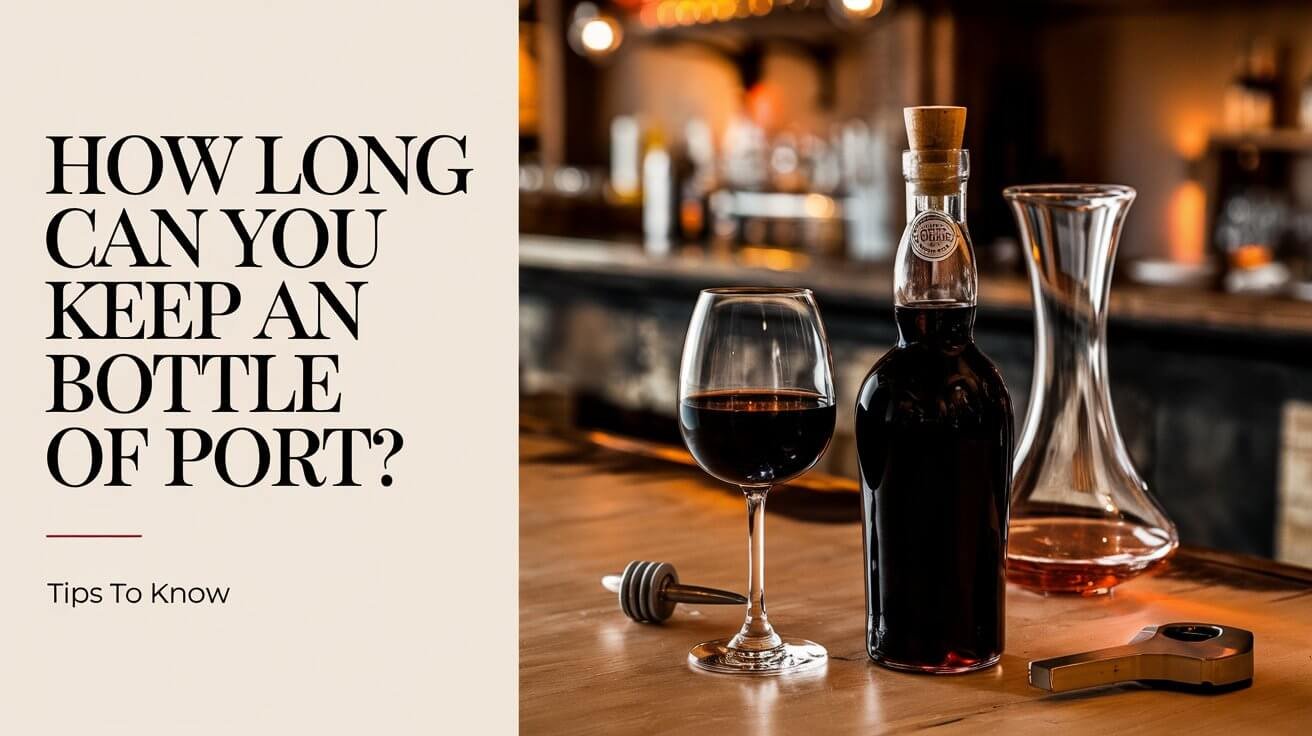How Long Can You Keep an Open Bottle of Port?

Wine lovers often wonder how long an open bottle of port can last. The answer depends on the port type and storage conditions. For example, a Vintage Port from a top brand like Quinta do Noval can stay good for 2-3 days. On the other hand, a Tawny Port can keep for weeks.
It’s important to know how to store open port to keep it fresh. Whether you prefer Ruby, Tawny, or White Port, proper storage is key. In this article, we’ll explore port wine types, their storage times, and tips for keeping your port fresh. This way, you can fully enjoy your port wine experience.
Port Wine Storage Timeline
Storing port wine after opening depends on the type and storage conditions. Knowing how long port lasts after opening is key to keeping it perfect. Port wine is known for lasting long, but the right storage is vital.
The best storage temperature for port is 10-15°C (50-59°F). This keeps the wine’s flavor and aroma. Ruby and late bottled vintage ports last up to two weeks in the fridge. Tawny and white ports can last a month.
Ruby Port Storage Duration
Ruby ports, like Founders Reserve Ruby Port, may fade in 4 or 5 weeks after opening. But, some ports like Sandeman’s 10 or 20 Year Old Tawny Port stay great for 10 or 12 weeks. Keep port in a cool, dark place to preserve it.
Tawny Port Shelf Life
Tawny ports stay good for months after bottling. Younger Colheitas last 4 weeks without losing flavor or aroma. Older vintages should be drunk quickly, within 48 hours. T-stopper closures help keep the wine fresh longer.
Vintage Port Considerations
Vintage ports age for decades, but once opened, they should be drunk soon. Young Vintage Ports (less than 5 years) are best in 4 to 5 days. Older Vintages (more than 15 years) should be drunk in 2 to 3 days. Really old Vintage Ports (over 25 years) should be enjoyed the same day or within 48 hours.
Optimal Storage Temperature Range
To find the best way to store opened port, knowing the right temperature is key. The best temperature for Port wine is between 8°C to 10°C. This slows down oxidation and keeps the wine’s quality high.
Storing unopened Port should be in a cool, dark spot between 50-65 degrees Fahrenheit. Once opened, the storage needs change. For example, tawny ports can stay good for 3 weeks in the fridge, while ruby ports last up to 2 weeks. Keeping your Port at the right temperature is vital.
Some Port wines, like the 2016 Late Bottled Vintage Unfiltered Port by Quinta do Noval, need proper storage. This wine is known for its rich flavors of blackberry and blackcurrant. Storing your Port at the best temperature ensures you get to enjoy its full taste and smell.
Here are some tips for storing different Port types:
- Tawny ports: 3 weeks in the refrigerator
- Ruby ports: 2 weeks in the refrigerator
- Vintage ports: 24 hours to 1 week after opening
- White ports: 2 weeks in the refrigerator
Keep your Port at the right temperature with these tips to fully enjoy its taste and aroma.
Air Exposure Impact on Port Quality
Air exposure can greatly affect the quality of opened port wine. Oxidation can spoil the wine, making it key to understand how to reduce its impact. To keep port fresh, consider storage conditions and the type of closure.
Experts say the port wine’s type and age influence its shelf life. For example, Vintage Ports under 5 years can last 4-5 days. Older ones are best enjoyed in 2-3 days. Unfiltered LBV Ports can stay fresh for up to two weeks in a cool spot.
Oxidation Process
Storing opened port in a fridge or wine fridge can slow oxidation. This helps keep the wine’s flavors and aromas. The closure type, like a cork or screw cap, also affects the wine’s quality.
Cork vs. Screw Cap Effects
Ports with a standard cork should be drunk in 2 to 3 days for the best taste. Ports with a plastic, t-stopper cork can last 3 to 4 weeks. Knowing these differences helps in preserving opened port.
Vacuum Sealing Benefits
Vacuum sealing is a great way to keep port fresh. It removes air, slowing oxidation and preserving flavors and aromas. This method is good for ports meant to be enjoyed over time.
Port Storage Location Factors
When storing open port, the location is key to keeping it fresh. Temperature and humidity are very important. Experts say the best spot is a cool, dark place with a temperature of 50-60°F (10-15°C) and humidity of 50-70%. A cellar or wine fridge works well.
Keep open port away from sunlight and heat. These can spoil the wine fast, losing its taste and smell. Choose a spot with little light and a steady temperature. A wine fridge or a cool, dark closet is perfect.
Here are some tips for storing open port:
- Store in a cool, dark place with a consistent temperature
- Keep away from direct sunlight and heat sources
- Use a wine fridge or a cool, dark closet
- Monitor the temperature and humidity levels
Keep your port wine fresh longer with these tips. Always check the wine before drinking, and if it’s spoiled, it’s best to discard it.
| Port Type | Storage Location | Temperature | Humidity |
|---|---|---|---|
| Ruby Port | Cool, dark place | 50-60°F (10-15°C) | 50-70% |
| Tawny Port | Cool, dark place | 50-60°F (10-15°C) | 50-70% |
| Vintage Port | Cool, dark place | 50-60°F (10-15°C) | 50-70% |
Signs Your Open Port Has Gone Bad
It’s key to keep an eye on your opened Port’s condition. If you’ve stored it for a while, check for signs of spoilage. Look for visual, aroma, and taste changes.
First, check the Port’s look. Look at its color, clarity, and sediment. Any big changes might mean it’s gone bad. Next, smell it. An unusual smell could mean it’s spoiled.
Visual Indicators
Some signs of bad Port include:
- Sludge or sediment at the bottom of the bottle
- Cloudy or hazy appearance
- Color change, such as a darker or lighter hue
Aroma Changes
Changes in smell can also warn you. If you notice:
- Unpleasant or sour smell
- Vinegar-like aroma
- Musty or moldy scent
Taste Alterations
Lastly, taste the Port. If it tastes bad, it’s likely spoiled. Look out for:
- Bitter or sour taste
- Flat or dull flavor
- Unpleasant aftertaste
By watching for these signs, you can keep your Port fresh longer.
| Port Type | Storage Life |
|---|---|
| Vintage Port | 24 hours to 1 week |
| Ruby Port | 4-6 weeks |
| Tawny Port | 4-6 weeks |
| White Port | up to 3 weeks |
How Long Can You Keep an Open Bottle of Port in Different Settings
Storing an open bottle of port can last from a few days to a few months. How long can you keep an open bottle of port depends on the type and storage conditions. Wine lovers often ask this question.
Here are some general guidelines for storing open bottles of port:
- Vintage Port: 4-5 days for youthful, 2-3 days for older, and 24-48 hours for very old
- LBV Port: 2-3 weeks for unfiltered, 10-12 days for filtered
- Colheita Port: 2-3 weeks for youthful, 3-4 days for older
- Aged Tawny Port: 2 months
- Ruby & Tawny Ports: 4-6 weeks
- White Port: up to 3 weeks, ideally 1-2 weeks
To keep an open bottle of port fresh, store it in a cool, dark place. This could be a fridge or wine cellar. The best storage varies by port type. For example, LBV Port needs to be cool (8°C – 10°C), while Aged Tawny Port should be stored in a cool-dark spot.
| Type of Port | Opened Shelf Life | Storage Recommendations |
|---|---|---|
| Vintage Port | 4-5 days (youthful), 2-3 days (older), 24-48 hours (very old) | Store in a cool, dark place |
| LBV Port | 2-3 weeks (unfiltered), 10-12 days (filtered) | Store cool (8°C – 10°C) |
| Colheita Port | 2-3 weeks (youthful), 3-4 days (older) | Store in a cool, dark place |
| Aged Tawny Port | 2 months | Store cool-dark |
| Ruby & Tawny Ports | 4-6 weeks | Store in a cool, dark place |
| White Port | up to 3 weeks, ideally 1-2 weeks | Store in fridge, finish within 1-2 weeks |
Enjoy your port longer by following these guidelines and storing it properly. Always check for signs of spoilage, such as changes in smell and taste, before drinking.
Port Preservation Tools and Methods
Storing open port requires the right tools and methods to keep its flavor and quality. Preserving port after opening can be tricky. But, with the right techniques, you can enjoy it for longer. Wine preservers are effective because they remove air from the bottle, stopping oxidation and spoilage.
Using storage containers made for wine is another good method. These containers are airtight, keeping air out and preventing spoilage. Refrigeration techniques also help by slowing down oxidation, extending the port’s shelf life. Storing the port in a wine fridge or cooler with a steady temperature is a popular choice.
Effective Preservation Methods
- Wine preservers: remove air from the bottle to prevent oxidation
- Storage containers: airtight containers designed for wine storage
- Refrigeration techniques: slow down oxidation by storing in a wine fridge or cooler
These preservation methods help you enjoy your port longer while keeping its flavor and quality. It’s also key to remember that the type of port and its storage can impact its shelf life. For instance, vintage port needs more careful storage than ruby port. Knowing these methods ensures your port is stored and served perfectly.
| Port Type | Storage Conditions | Shelf Life |
|---|---|---|
| Ruby Port | Cool, dark place | 2-4 weeks |
| Vintage Port | Refrigerated, airtight container | 2-6 months |
Common Port Storage Mistakes
Storing Port wine right is key to keeping its quality. Knowing the best way to store opened port is very important. It affects the wine’s taste and how long it lasts.
Some common errors include keeping the wine too warm, exposing it to light, and using the wrong closure. To avoid these, store the wine in a cool, dark spot. This could be a wine cellar or fridge. Always use a wine stopper or vacuum seal to stop air from getting in.
Here are some tips for storing your Port wine correctly:
- Store the wine in a cool, dark place, such as a wine cellar or refrigerator.
- Use a wine stopper or vacuum seal to prevent oxidation.
- Keep the wine away from light and heat sources.
- Store the wine upright to prevent the cork from becoming damaged.
Your Port wine will stay fresh and tasty for longer with these tips. Store opened Port in a cool, dark spot and use a wine stopper or vacuum seal to keep air out.
| Port Wine Type | Storage Life |
|---|---|
| Ruby Port | 1-2 months |
| Tawny Port | 2 months |
| Vintage Port | varies |
Professional Storage Tips from Port Houses
Port houses have tips to keep opened Port fresh longer. These tips are key for anyone wanting to enjoy their Port longer. By following these guidelines, your opened Port will stay fresh and flavorful.
Proper storage is key to keeping opened Port good. Keep the bottle away from sunlight and heat. Also, using a vacuum pump or inert gas system can stop oxidation and spoilage.
Decanting Practices
Decanting is a must for serving Port wine. It separates the wine from sediment. When decanting, do it slowly and carefully to avoid stirring up sediment.
Serving Recommendations
Use a clean, dry glass when serving Port wine. This prevents contamination or flavor changes. Serving Port at the right temperature also enhances its flavor and aroma. Follow these tips to enjoy your Port longer and appreciate its unique taste.
Popular ways to keep opened Port fresh include champagne stoppers or private preserve systems. These methods can keep the wine fresh for weeks or months. Investing in one of these systems means you can enjoy your Port without worrying about it spoiling.
Ending Thoughts
The time you can keep an open bottle of Port wine varies. Ruby Port lasts only a few days, while Tawny Port can stay good for up to three weeks in the fridge. Vintage Port should be drunk within a day or two to keep its flavors.
Port wine has a long history, starting in the 17th century. It’s known for its sweet smell and taste. Today, it’s loved worldwide, with Tawny Ports aged for 3-7 years. The right storage is key to enjoying its full flavor.
Your Port wine will stay fresh by following the storage tips in this article. This lets you enjoy its rich taste fully. With a bit of care, you can make your Port-drinking experience even better.




